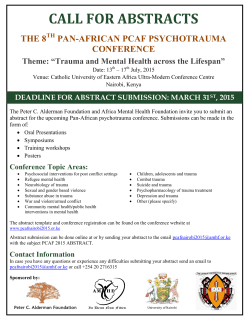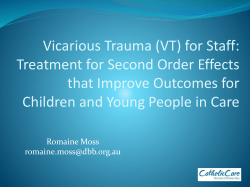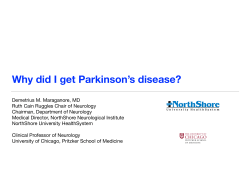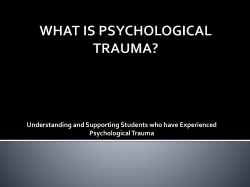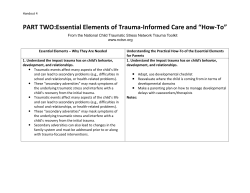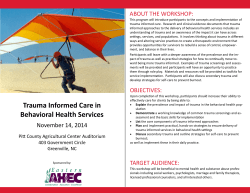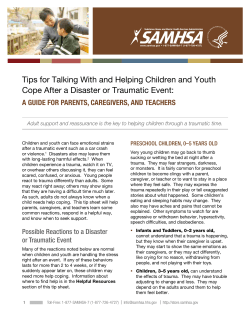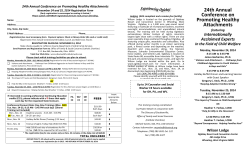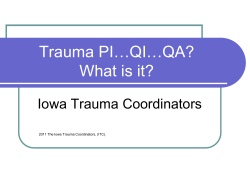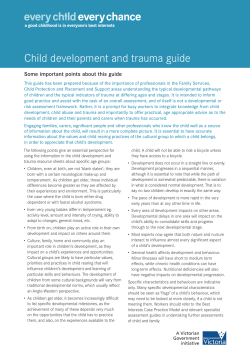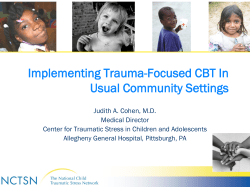
What Parents Can Do Helping Children and Adolescents Cope with Violence and Disasters
National Institute of Mental Health Helping Children and Adolescents Cope with Violence and Disasters For Parents of Children Exposed to Violence or Disaster What Parents Can Do Each year, children experience violence and disaster and face other traumas. Young people are injured, they see others harmed by violence, they suffer sexual abuse, and they lose loved ones or witness other tragic and shocking events. Parents and caregivers can help children overcome these experiences and start the process of recovery. What is trauma? “Trauma” is often thought of as physical injuries. Psychological trauma is an emotionally painful, shocking, stressful, and sometimes life-threatening experience. It may or may not involve physical injuries, and can result from witnessing distressing events. Examples include a natural disaster, physical or sexual abuse, and terrorism. Disasters such as hurricanes, earthquakes, and floods can claim lives, destroy homes or whole communities, and cause serious physical and psychological injuries. Trauma can also be caused by acts of violence. The September 11, 2001 terrorist attack is one example. Mass shootings in schools or communities and physical or sexual assault are other examples. Traumatic events threaten our sense of safety. Reactions (responses) to trauma can be immediate or delayed. Reactions to trauma differ in severity and cover a wide range of behaviors and responses. Children with existing mental health problems, past traumatic experiences, and/or limited family and social supports may be more reactive to trauma. Frequently experienced responses among children after trauma are loss of trust and a fear of the event happening again. It’s important to remember: • Children’s reactions to trauma are strongly influenced by adults’ responses to trauma. • People from different cultures may have their own ways of reacting to trauma. Commonly experienced responses to trauma among children: Children age 5 and under may react in a number of ways including: • • • • • • • • • • Showing signs of fear Clinging to parent or caregiver Crying or screaming Whimpering or trembling Moving aimlessly Becoming immobile Returning to behaviors common to being younger Thumbsucking Bedwetting Being afraid of the dark. Children age 6 to 11 may react by: • • • • • • • • • • • • • • • • Isolating themselves Becoming quiet around friends, family, and teachers Having nightmares or other sleep problems Refusing to go to bed Becoming irritable or disruptive Having outbursts of anger Starting fights Being unable to concentrate Refusing to go to school Complaining of physical problems Developing unfounded fears Becoming depressed Expressing guilt over what happened Feeling numb emotionally Doing poorly with school and homework Losing interest in fun activities. Adolescents age 12 to 17 may react by: • Having flashbacks to the event (flashbacks are the mind reliving the event) • • • • • • • • • • Having nightmares or other sleep problems Avoiding reminders of the event Using or abusing drugs, alcohol, or tobacco Being disruptive, disrespectful, or behaving destructively Having physical complaints Feeling isolated or confused Being depressed Being angry Losing interest in fun activities Having suicidal thoughts. Adolescents may feel guilty. They may feel guilt for not preventing injury or deaths. They also may have thoughts of revenge. What can parents do to help? After violence or disaster, parents and family members should identify and address their own feelings — this will allow them to help others. Explain to children what happened and let them know: • • • • You love them The event was not their fault You will do your best to take care of them It’s okay for them to feel upset. Do: • • • • • Allow children to cry Allow sadness Let children talk about feelings Let them write about feelings Let them draw pictures about the event or their feelings. Don’t: • • • • Expect children to be brave or tough Make children discuss the event before they are ready Get angry if children show strong emotions Get upset if they begin bedwetting, acting out, or thumbsucking. Other tips: • If children have trouble sleeping give them extra attention, let them sleep with a light on, or let them sleep in your room (for a short time). • Try to keep normal routines, for example, reading bedtime stories, eating dinner together, watching TV together, reading books, exercising, or playing games. If you can’t keep normal routines, make new ones together. • Help children feel in control when possible by letting them choose meals, pick out clothes, or make some decisions for themselves. How can I help young children who experienced trauma? Helping children can start immediately, even at the scene of the event. Most children recover within a few weeks of a traumatic experience, while some may need help longer. Grief, a deep emotional response to loss, may take months to resolve. Children may experience grief over the loss of a loved one, teacher, friend, or pet. Grief may be re-experienced or worsened by news reports or the event’s anniversary. Some children may need help from a mental health professional. Some people may seek other kinds of help from community leaders. Identify children who need support and help them obtain it. Examples of problematic behaviors could be: • Refusing to go to places that remind them of the event • Emotional numbness • Behaving dangerously • Unexplained anger/rage • Sleep problems including nightmares. Adult helpers should: Pay attention to children • Listen to them • Accept/do not argue about their feelings • Help them cope with the reality of their experiences. Reduce effects of other stressors, such as • Frequent moving or changes in place of residence • Long periods away from family and friends • Pressures to perform well in school • Transportation problems • Fighting within the family • Being hungry. Monitor healing • It takes time • Do not ignore severe reactions • Pay attention to sudden changes in behaviors, speech, language use, or strong emotions. Remind children that adults • Love them • Support them • Will be with them when possible. Parents and caregivers should also limit viewing of repetitive news reports about traumatic events. Young children may not understand that news coverage is about one event and not multiple similar events. Help for all people in the first days and weeks There are steps adults can take following a disaster that can help them cope, making it easier for them to provide better care for children. These include creating safe conditions, remaining calm and friendly, and connecting with others. Being sensitive to people under stress and respecting their decisions is important. When possible, help people: • • • • • • • • Get food Get a safe place to live Get help from a doctor or nurse if hurt Contact loved ones or friends Keep children with parents or relatives Understand what happened Understand what is being done Know where to get help. Don’t: • Force people to tell their stories • Probe for personal details • Say things like “everything will be OK,” or “at least you survived” • Say what you think people should feel or how people should have acted • Say people suffered because they deserved it • Be negative about available help • Make promises that you can’t keep such as “you will go home soon.” More about trauma and stress Some children will have prolonged mental health problems after a traumatic event. These may include grief, depression, anxiety, and post-traumatic stress disorder (PTSD). Some trauma survivors get better with some support. Others may need prolonged care from a mental health professional. If after a month in a safe environment children are not able to perform normal routines or new behavioral or emotional problems develop, then contact a health professional. Factors influencing how someone may respond include: • Being directly involved in the trauma, especially as a victim • Severe and/or prolonged exposure to the event • Personal history of prior trauma • Family or personal history of mental illness and severe behavioral problems • Limited social support; lack of caring family and friends • Ongoing life stressors such as moving to a new home or new school, divorce, job change, or financial troubles. Some symptoms may require immediate attention. Contact a mental health professional if these symptoms occur: • Flashbacks • Racing heart and sweating • Being easily startled • Being emotionally numb • Being very sad or depressed • Thoughts or actions to end one’s life. Trauma resources Access to disaster help and resources: Website: http://www.disasterassistance.gov Centers for Disease Control and Prevention Website: http://emergency.cdc.gov/mentalhealth Federal Emergency Management Agency Phone: 1-800-480-2520 Website: http://www.fema.gov/kids National Center for PTSD Website: http://www.ptsd.va.gov The National Child Traumatic Stress Network Website: http://www.nctsn.org Substance Abuse and Mental Health Services Administration Disaster Distress Helpline Phone: 1-800-985-5990 Website: http://www.disasterdistress.samhsa.gov Uniformed Services University of the Health Sciences Center for the Study of Traumatic Stress Website: http://cstsonline.org U.S. Department of Justice Office for Victims of Crime Website: http://www.ovc.gov/help/index.html If you or someone you know is in crisis or thinking of suicide, get help quickly. • Call your doctor. • Call 911 for emergency services or go to the nearest emergency room. • Call the toll-free 24-hour hotline of the National Suicide Prevention Lifeline at 1-800-273-TALK (1-800-273-8255); TTY: 1-800-799-4TTY (4889). Where can I find more information? To learn more about trauma among children, visit: MedlinePlus (the National Library of Medicine): http://medlineplus.gov (En Español: http://medlineplus.gov/spanish) For information on clinical trials, visit: ClinicalTrials.gov: http://www.clinicaltrials.gov For more information on conditions that affect mental health, resources, and research, go to MentalHealth.gov at http://www.mentalhealth.gov, the NIMH website at http://www.nimh.nih.gov, or contact us at: National Institute of Mental Health Office of Science Policy, Planning, and Communications Science Writing, Press, and Dissemination Branch 6001 Executive Boulevard Room 6200, MSC 9663 Bethesda, MD 20892–9663 Phone: 301-443-4513 or 1-866-615-NIMH (6464) toll-free TTY: 301-443-8431 or 1-866-415-8051 toll-free Fax: 301-443-4279 Email: nimhinfo@nih.gov Website: http://www.nimh.nih.gov Reprints This publication is in the public domain and may be reproduced or copied without permission from NIMH. We encourage you to reproduce it and use it in your efforts to improve public health. Citation of the National Institute of Mental Health as a source is appreciated. However, using government materials inappropriately can raise legal or ethical concerns, so we ask you to use these guidelines: • NIMH does not endorse or recommend any commercial products, processes, or services, and our publications may not be used for advertising or endorsement purposes. • NIMH does not provide specific medical advice or treatment recommendations or referrals; our materials may not be used in a manner that has the appearance of such information. • NIMH requests that non-Federal organizations not alter our publications in ways that will jeopardize the integrity and “brand” when using the publication. • Addition of non-Federal Government logos and website links may not have the appearance of NIMH endorsement of any specific commercial products or services or medical treatments or services. If you have questions regarding these guidelines and use of NIMH publications, please contact the NIMH Information Resource Center at 1-866-615-6464 or email at nimhinfo@nih.gov. u.s. DepaRtment of HealtH anD Human seRvices National Institutes of Health NIH Publication No. 13–3518 Revised 2013
© Copyright 2025


